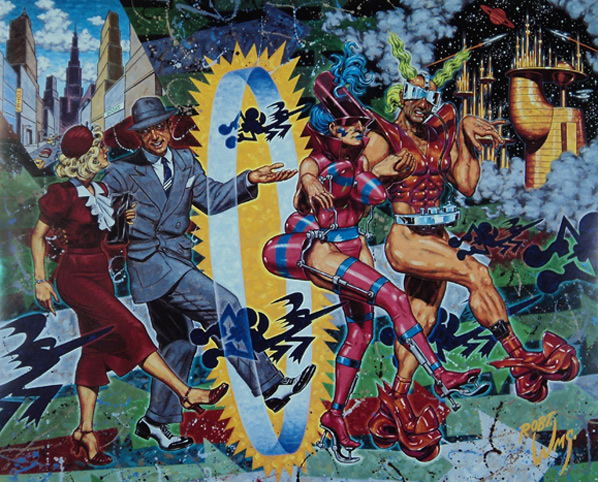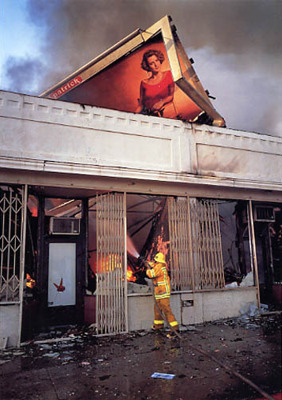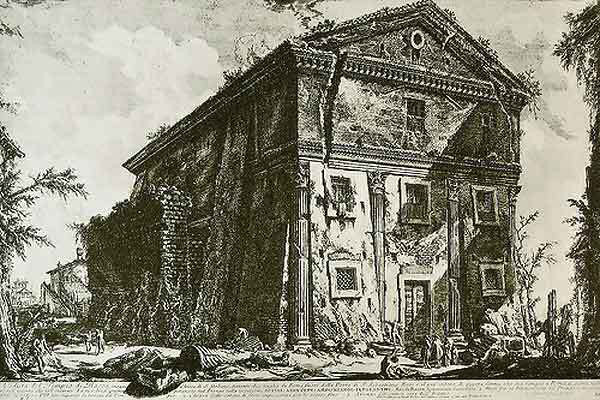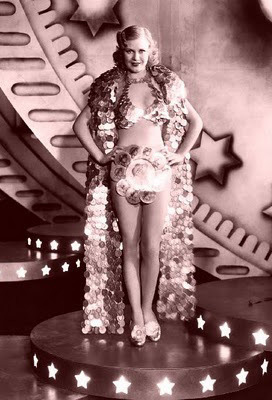Notes on the Arts: Curating the Past 50 Years as Ruin
by Norman M. Klein

Robert Williams, Vanity of the New, 1991. Oil on canvas, 40 x 46 in. Courtesy of Tony Shafrazi Gallery, New York.
In the midst of our economic and political crisis, we must assume that art history will be remade. New points of origin will be invented, probably starting with the 1960s instead of the 1860s. Fluxus, Archigram, Conceptual art, Minimalism, Pop—1968 and “all that”—as well as sixties performance and video are now understood as the beginning, not the finale.
Of course, that raises the question: the beginning of what? Art specialists often agree on the ten or five basic causes of our disastrous moment (though almost never on the order in which they occurred). For example: when deconstruction became a redundant term; when the postmodern era ended; when biopolitics was officially harvested within the arts; when Las Vegas came to also symbolize financial crashes. One last straw “after” the other. These causes are usually linked to globalism and neoliberalism. We each have our capsule summary. All of them are correct. Mine goes essentially like this:
During the 1970s, in the US, the alliance between industrial capitalism and the nation-state broke apart. In its place, decade by decade, an alternative emerged. I often call this alternative an “uneasy” alliance. Compare it to Baroque politics in the seventeenth century. I’ll explain briefly: Let us call the seventeenth century “postfeudalism,” rather than “early modern Europe.” Absolutism was a myth, the monarchies in Europe were very fragile, and the “postfeudal” kings of England and France turned to the wealthy bourgeoisie to help them survive. But the businessmen were the natural enemies of that kind of king. From the 1620s on, the business class dismantled what remained of that kind of monarchy, and even decapitated the kings.
In much the same way, what we call global capital is bent on deregulating and dismantling the American nation-state. Presidents will no longer be asked to invade foreign countries to foster investment. Instead, the United States itself is being invaded by its own economy. Thus, consumerism and poststructuralism and “late” capitalism all point toward a new relationship between culture and power within the United States. In the meantime, artists have become the new courtiers for the collapse of sovereignty in the US. (That includes me. I often call myself an unkosher rabbi. Whenever I say the meat is not safe, somehow they cook it even sooner. I guess, in some way, I only add more spice.)
However, as of late, all of us in the arts professions float in a kind of void. The rules and courtesies, the good and bad faith, are in flux. How to dress, how to speak? In my case, I have decided to chronicle the “comic-tragedy” of the US itself with picaresque stories about “the dismantling of the American psyche.”1
I begin my story of these comic woes in 1971, at the end of Nixon’s first administration. But I can also see that high modernism in the sixties—and the poststructural ironies of the dissolving of the Cold War after 1962—contain an incipient sense of ruin. The cosmopolitanism of the sixties is to culture in the US what bourgeois Enlightenment was to “postfeudalisms” in 1700. Of course, with one monstrous difference: the bourgeoisie by 1800 did, on occasion, between nightmares, leave some room for “the rights of man” (even eventually of women and non-whites). There was a ratchet effect upward, brutal as it was, and the middle class and organized labor did grow, in stages, in Europe and the US.

Allan Sekula, Fish Story Special Edition, Koreatown, Los Angeles, 1992. C-print mounted on aluminum, plexiglass, wooden frame. Courtesy of the artist and Christopher Grimes Gallery, Los Angeles.
But that process switches after 1973. In what is increasingly a “neofeudal” system, we keep turning more toward oligarchy. We in the West are dismantling, even forgetting, the Jeffersonian Enlightenment, in favor of a warlord economy run through computers by global vampiric risk capitalists–a barbarian horde essentially. We have also noticed that digital clouds of data can be fragile. They can be easily gamed, hacked, erased, converted into derivative bonds, hedge funds, and tax havens. Who needs bag men when you have computers worldwide, interconnected but with cosmically vast gaps big enough to bankrupt a country? Fragile software can freeze your car, accidentally freeze your credit. It is a new process with an old problem, a climate dominated by unreliable weather.
So we must adapt how we research the sixties and seventies. From Buckminster Fuller to Conceptual art, the apparatus of ruin is now essential to understanding high modernism in the sixties, and in understanding how postmodern consumerism must be revalued. The shocks since 2008 make that inevitable. A shift in curating will be increasingly obvious. Many more retrospective exhibitions will attempt a “new” genealogy. Curators will need to start with a different clock for the fifties and early sixties. In terms of Southern California, a few exhibitions since 2005 have already tried to do that, like the “New Topographics” show at LACMA (a 2009 re-creation of a 1975 photo exhibition of “man-made landscapes”), and, of course, the retrospective at the Centre Georges Pompidou, Paris, in 2006 titled “Los Angeles, 1955–1985: The Birth of an Art Capital.”
The trend is clearly to ignore the rhythmic suburbanism of LA that was identified with the fifties. For many years, of course, Allan Sekula has done precisely that, with scrupulous care. For our purposes here, we can mentally drift back to how shows were curated during the nineties, to Blade Runner–esque retrospectives like “Helter Skelter: LA Art in the 1990s” or “Sunshine and Noir: Art in LA, 1960–1997.”2I assume that retrospectives to come will ignore all that cyberpunk/noir affect. In the era of bio art and melting glaciers, we don’t need gothic atmospherics from the nineties; except perhaps through caricature, and in new directions among grafitti artists. I also assume that it is now common knowledge among curators (as historians like Mike Davis have told us for decades) that the passage from noir to cyberpunk (roughly the period of 1955–97) was not intended to adequately reveal Los Angeles. Instead, noir strategies were designed—by authors, filmmakers, and curators—to help obscure Los Angeles; to “erase,” to forget, far more than to uncover. Erasure made the stories fiercer; they made LA more legible, not more precise. Noir delivered atmospheric, existentialist anti-tourism (for “slumming angels,” as the novelist Ross Macdonald put it), but it was tourism nonetheless.3
This difference can be tricky, like threading the line between fatalism and nihilism; particularly in our era—by that I mean 2009 to 2012, if three years is long enough to be called an era. Like a stockbroker still moaning in 1931, we seem to be consumed at the moment by melancholy more than by consumerism, by shock more than by master planning. We feel collectively trapped in Hoover’s second administration.

Giovanni Battista Piranesi, Tempio di Cerere e Faustina, 1756. Etching. Courtesy of Wikicommons.
With that mood in mind, we can return to the question at the opening of this essay, to the matter of how we redo art history after the Crash. What is the best way to express how we feel now about fifties high modernism, about Googie buildings and space needles, Brutalism and dingbat architecture?4What would be suitably ironic for us, as we look back—and yet accurate for 1955–1980? Were the fifties, despite all that explosive growth, a Piranesian road to eighties decay? Can Piranesi’s melancholy be compared to the ruins of Rancho Cucamonga in 2010, to shopping malls voided by for-lease signs?5
The ruin was indeed a flexible tool in Baroque art, and also in the Gothic Revival of the 1890s. It was about the collective subconscious; it was comic. Like special effects cinema today, the Baroque ruin of the world was often exhibited—in the theater, in public displays at the city wall, and as gigantic fireworks extravaganzas that also consumed ephemeral architecture, in order to reenact the eruption at Pompeii or the latest naval victory. Gaudy ruins enhanced what was obvious in the seventeenth century, that the world was dissolving despite efforts at absolutism, despite attempts to revive feudalism, but with new economic partners (the king forming alliances with the bourgeoisie, for example, in order to fund mindless wars and brain-numbing moral campaigns). Within this world of high-stakes artifice, even capital itself could turn into gaudy spectacles about ruin. Money and ruin were often a special effect. In Spain circa 1580, for example, the official policy of the crown was bullionism, the belief that precious metals like silver and gold were more valuable than industry and farming. Like the “Tea Party,” the Spanish monarch dismantled many of the key industries within Spain merely to hoard gold and silver. But in order to buy time to gather all his lucre, the king needed loans. These came through Dutch bankers who, in turn, bled his economy dry. All this, and the politics of fundamentalist armies dissolving borders while monarchs paid fortunes for elaborate media events. Sounds familiar, no?

Deborah Aschheim, Theme Building (Now I Miss the Scaffolding), 2010. Ink on Dura-Lar, 20 x 36 in. Courtesy of Edward Cella Gallery.
Would that work for us now, as a melancholic joke about decades of bank simulation, derivatives, and risk capitalism? In her exhibition “Nostalgia for the Future,” at Edward Cella Gallery in 2010, Deborah Aschheim added Piranesian scaffolding in her drawings of “ruined” buildings from the mid-sixties, including Welton Becket’s Theme Building at the Los Angeles International Airport, the Capitol Records building in Hollywood, and the mostly abandoned Ambassador College campus in Pasadena. She selected these and other modernist sites for their “tragic and incessant sense of obsolescence.” “When I was growing up,” she explained, “the future was limitless possibility, jet-age, space-age, techno-utopia. ‘Modern’ meant new. Now modern means old and the future I grew up with seems dated, irresponsible, and obsolete.” Her quote from Nabokov is appropriate here: “The future is but the obsolete in reverse.”6
Of course, that must be said for all archival collecting. That is its virtue, its mission, to gather ruins that help us redefine art history. At the Getty Research Institute Library, over the past decade or so, numerous collections that re-map the past fifty years have been bought; for example, the papers of Robert Irwin, Allan Kaprow, Carolee Schneemann; “Minimal and Conceptual Art documents”; rare archives for Harry Smith and LA Pop; as well as an extensive video art collection—all part of a concerted effort. In 2011–12, many of these will be spread across more than forty venues, as part of the Getty-sponsored “Pacific Standard Time: Art in LA, 1945-1980.”7
Of course, it is unlikely that all this effort will complete any transition. We are in the process of archiving, not setting up a master system, much less a “new canon,” after decades of removing the canon. As I often add, historians will be laughing their asses off about us for centuries; so we may as well get started early. But how to manage that, with the same energy it was made with? That remains the challenge.
I certainly keep getting the signals crossed. This will be a gradual synthesis, I suspect. Below is an excerpt from an interview that I gave via email in 2007, on the “New Canon,” with curator Jelle Bouwhuis of the Stedelijk Museum in Amsterdam. Even while I typed these comments, the boom was ending in the US. In interviews, I often warned about a crash about to begin, but mostly this was a theatrical gesture; it is often difficult to see what is obvious.
As my conclusion, I will update what I said then:
Klein: …The history of the last fifty years is increasingly about the crisis in representing space, from conceptual space to virtual space to cyberspace to cinematic space to public space to intimate space/identity. And the era when these Scripted Spaces, these narratized, themed illusions began to take over begins around 1955. And not only in the fine arts, of course, also in architecture, in urban planning, in themed environments. And finally, in media environments—directly into the Internet, games, media art. At last, we begin to see the new canon emerging, for as surely as the stock market opens every Monday, a canon must emerge in the art world. Even if it is an anti-canon. But is it an anti-canon really? Instead of abstraction, we have the ironic staging of space. Instead of
Enlightenment traditions of the ontological real, we have Artifice, the art of the handmade illusionistic space.And even museums are being redesigned, reinvented as cultural tourism. Space is problematical, an allegory for global madness, a soothing journey into a sublime nowhere, a reenactment of the invasion of the self by entertainment, which stands in for global economic authority. The canon then will be more architectonic, more about themed illusion, trace the end of irony, let us say, from Pop into hyperbolic home entertainment. Both Pop and Minimalism are potential points of origin, not the postmodern moment, but rather a postwar paradigm as starting point. Pop is the figurative scripted space. Minimalism in the victory of entertainment/design.
It is only a matter of time before this emerging canon—and canons are always problematical, and anti-canonical—becomes a standard place to start a conference. We may think this is an evasion, but isn’t canon always something of an evasion? It is a discourse, not an answer. This new canon, post 1955, will only be valuable if it generates its own problems effectively. After all, modernism and postmodernism may be over, but dialectical logic is still the best way to keep art history alive.
Bouwhuis: If Scripted Space is the key term for the new canon, or anticanon, why should it start in the 1950s? In The Vatican to Vegas you make perfectly clear that it already functioned in the Baroque era.
Klein: Clearly all spaces are scripted to some degree (designed as narrative journeys for the viewer). But in the US, at any rate, from the mid-fifties on, vast shifts in how public spaces were scripted can be seen. I’ll set up a skeletal map of the larger process:
1. Themed environments, from Disneyland to the first modernist
expansion of Las Vegas, to fast food companies like McDonald’s, to
early shopping centers…2. The City of Circulation; Massive freeway programs across the US
after 1953; puncturing the centripetal city; vast erasures of downtown
areas, and so-called “blighted” inner city neighborhoods, often to
speed up circulation, to diminish the power of older urban centers.3. Suburban takeoff; the vast hemorrhaging of American inner cities
becomes apparent after 1955.4. Massive growth in home entertainment, as television leads a
series of technological replacements for the public space. The movie
monopolies are broken after 1948 and hit bottom by the mid-fifties. For
decades, movie viewing goes down, until Hollywood learns to form
alliances with home entertainment and with suburban multiplex,
themed mall culture.5. The coming of age of adolescent culture, rock and roll, etc., a
very different staging of public life, of celebrity, of glamour—far
beyond the bobby-soxer thirties and forties.6. Variations of Pop across the fine arts, in response to the sudden
hegemony of this much expanded entertainment economy.7. Minimalism, as the twin of Pop, aestheticizes what becomes the
designer culture for a much larger technologically driven consumer
culture.8. The takeoff point of the NATO economy across Western Europe and the
US marks a beginning of what we understand as globalization today.9. After 1955, the shocks of postcolonialism become increasingly apparent in East Asia, the Middle East, and Africa after 1955. Thus another starting point for what we identify as the global economy—and its
crises.10. In Europe and the US, key texts on media theory and structuralist
(then poststructuralist) examination of the production of space, etc.11. Essential research toward our nanoculture today: transistors;
precursors to the Internet; early games; advanced simulation systems;
adding “surface” to the wire-frame in design, etc.
Thus, 1955 (or should I say, 1953–57?) is a knot that helps clarify what became the culture of themed, electronic Baroque spaces. Circa 1955 is becoming a point of origin increasingly in art theory about the consumerist, themed entertainment economy. And at the heart of this transformation, we find the victory of home entertainment, of games and gaming, of staged, immersive illusion across the media—the culture of Artifice. We also find the road to marketing culture utterly changed: Any art form that cannot also join cultural tourism or home entertainment will suffer shrinking markets over the next generation. The scripted space, whether on the iPhone or at the museum, becomes the crucial paradigm for success—also the key to distribution—profoundly altering literature, theater, the performing arts, and museum culture.”8
Update: What I failed to mention was that the Crash already under way, that the era of cultural tourism was about to change very powerfully. I also did not include any discussion of the anomie in American politics and culture. This is particularly evident from 1968 to 1975. I should have remembered. I went through it. Anyway, in 2006 I first describe a collective medicated stillness in American culture—a viral anxiety. I called it the antechamber effect: a collective “desensitized psyche.”9The antechamber effect is theatrical (a gothic script, a fright pretending to be about action). It is therefore highly evasive, like a game about avoidance.
I was expanding the principle of scripted space beyond high-consumerist architectonic issues. The term ‘scripted space’ also helped me understand our collective reply to the dismantling of the federal government, particularly after 9/11. But as of 2007, I still underestimated the political moon, in response to decades of deregulated, casino economy. I also hadn’t quite seen the adaptation that was beginning, after the loss of vertical sovereignty. These adaptations suggest a new regionalism, a globalized “trans-localism,” already under way in the US, in fact worldwide, from Europe to China. I did not see this properly. I have now set up a chronological map that might apply here.

Ginger Rogers in Gold Diggers of 1933, (1933).
I identify four cycles of dates, from 1955 to the present, which may seem very obvious but also match what our emerging art history may become. The first would be our “high modernist” moment, or the era of international modernism and structuralist postmodernism that took place from 1953–1971, with the rebuilding of the postwar NATO economy and culture as a bulwark against Soviet totalitarianism. It was a period of optimism, but also an era obsessed with policies of erasure, with a brinkmanship about the ruin of the West. Following that comes the 1970s, with the first stirrings of a globalized economy prefigured by Nixonian business reforms, OPEC, and the digitization of banking. In art this translates as an era of new technologies, especially video art. Next, during the years of 1980-2000, we experienced a golden age of simulation and globalism; not as the crisis of the sign, but rather as a new risk-capitalist version of freewheeling, deregulated finance—something more like the end of the political Enlightenment in the West than an era of poststructuralism. And finally, this past decade of 2000–2012, which has seen the dismantling of federal sovereignty in the United States and move us toward what is, as yet, undefined. This is not an oblivion, except for those who can retire on full pension. Culturally, it could be a golden age, a re-repurposing of American art and politics far different from modernism or postmodernism.